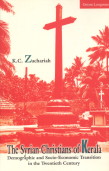‘The Syrian Christians of Kerala, Demographic and Socio-Economic Transition In The Twentieth Century’ by K. C. Zachariah

Note About the Author
Dr K C Zachariah is Honorary Fellow with Centre for Development Studies, Thiruvananthapuram . He has published number of books about demographic studies and transition. He is also the Principal author of the United Nations Manual on Internal Migration which was published under the auspices of the United Nations. ((http://www.saneinetwork.net/pdf/researchers/K_C_Zachariah.pdf ))
Overview
During the twentieth century, the Syrian Christian population of Kerala underwent a process of transition in its demographic transition in terms of size, composition, and growth rates of the Christian population in general and the Syrian Christian population in particular. It goes on to study the growth of the Christian population in Kerala in the context of the growth of the Christian population in India. The underlying demographic factors of transition-fertility, mortality, and migration-are analysed in detail. It describes the socio-economic transition of the Syrian Christians as seen in their education level, employment status, and material possessions. The discussions are carried out in a comparative setting, where corresponding changes that have come about in other communities-Hindus, Muslims, and Latin Christians-are also examined. The book concludes by drawing attention to projected demographic trends and their likely impact on the community. It suggests the need for some introspection by the Syrian Christians to cope with the adverse fall-out of the emerging trends.
Although this book is mainly about the Syrian Christians of Kerala, it includes most of the latest demographic information on Christians of all denominations in Kerala and on Christians across India. The book is, thus, a good reference document on the demography of Christians in India.
Its publication is of particular relevance today, when religion-wise data are receiving increasing attention and careful scrutiny. It is relevant from several other points of view as well. First, it puts together historical data on the demography and socio-economic development of the Syrian community in Kerala-data that are not readily accessible to the general public. Second, based on original data, again not available to the public, it provides comparative information between the current socio-economic status of the Syrian Christians and that of communities belonging to other religious groups;
A unique contribution of this book is the comparative analysis of demographic and socio-economic characteristics between various Christian denominations and communities falling within the larger Hindu and Muslim groups. Lastly, it brings to the attention of the Syrian Christian church leadership and of the Syrian church members problems that could arise from prospective demographic trends.
Contents
1. Social and economic transitions in the Syrian Christian community in the twentieth century: an overview.
2. The history of Christianity in India.
3. Growth of the Christian population in India.
4. Growth of the Syrian Christian population in Kerala.
5. Kerala Christians by denominations.
6. Demographic characteristics of Christians in Kerala.
7. Socio-economic profile of the Syrian Christians by the end of the twentieth century.
General Details
The book is published by Orient Longman Private Limited. A working paper is available online. The relevance of Dr. Zachariah’s book, should be viewed in light of the increasing need for statistical information and the general slackness on the part of the Syrian Christian churches in maintaining and utilizing statistical information.
The Author concludes with a statement that “The Syrian Christians are `notoriously lethargic’ in developing and maintaining basic information about the community. For the community to survive in the 21st century, its members should come together in the emerging era of demographic crises and jointly invest more of their resources in areas that matter the most, especially in the development of human resources.”


Its a thought provoking suggestion on how the community can survive in 21st century.Is any leaders listening.
Anoop,
The fact is that we have no leaders
we need one organisation and one leadership to lead the community in this new millenium
There is a good model from Georgian catholicose . In 2007 his holiness offered that he will be GODFATHER for the third child born to a couple in the year 2007 . Georgia which is suffering from population degrowth has now showing population growth due to this . Now the Catholicose become godfather for more than 2000 childs. This can be a followable practice for us which are facing the same problem .
I would like to get in touch with Dr K C Zachariah. Please forward my request to him or let me know his email ID.
Thanks, Nikhil Raghavan